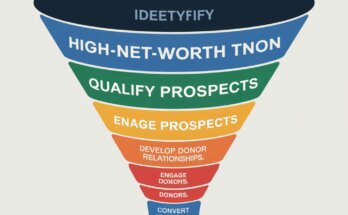In the nonprofit sector, one of the most significant challenges organizations face is securing funding to sustain their missions. This is where high-net-worth donors come in. These individuals have the financial means to make substantial contributions, and their support can be a game-changer for nonprofits.
However, attracting and engaging these donors requires more than just a compelling mission; it necessitates a dedicated and effective board.
In this blog post, we will explore the vital role of board members in attracting high-net-worth donors and provide practical strategies that your organization can implement.
The Importance of High-Net-Worth Donors
High-net-worth donors are individuals who possess substantial financial assets, typically defined as those with a net worth exceeding $1 million.
Their contributions can significantly impact a nonprofit’s ability to achieve its goals. Unlike small donors, high-net-worth individuals often have the capacity to give larger sums, making them critical allies in funding major initiatives.
According to recent studies, high-net-worth donors are often motivated by their personal experiences and philanthropic interests, making it essential for nonprofits to build strong relationships with them. By understanding what drives these donors, nonprofits can better tailor their approaches to secure lasting support.
The Board’s Role in Fundraising
Board members play a crucial role in the fundraising process. They are not just figureheads; they are instrumental in guiding the organization’s direction and cultivating donor relationships.
Here are some key responsibilities board members should embrace:
- Networking: Board members often have extensive networks that can be leveraged to identify potential high-net-worth donors. They should actively engage their contacts to raise awareness about the organization’s mission.
- Ambassadorship: Board members serve as ambassadors for the nonprofit. They should be able to effectively communicate the organization’s mission and impact to their networks, inspiring others to support the cause.
- Personal Contributions: High-net-worth donors often look to board members for leadership. When board members demonstrate their commitment by making personal contributions, it encourages others to follow suit.
Strategies for Engaging High-Net-Worth Donors
To attract and retain high-net-worth donors, board members should consider the following strategies:
- Develop Personal Relationships: Building personal relationships with potential donors is essential. Board members should take the time to learn about the interests and passions of high-net-worth individuals. For example, if a board member discovers that a potential donor is passionate about education, they can invite them to events related to educational initiatives the organization supports.
- Host Exclusive Events: Organizing exclusive events for high-net-worth donors can create a sense of belonging and community. Board members should take the lead in planning these events, which could include dinner parties, gallery tours, or private receptions. These gatherings provide an opportunity for potential donors to connect with the organization’s leadership and other like-minded individuals.
- Showcase Impact: High-net-worth donors want to see the impact of their contributions. Board members should be prepared to share success stories and demonstrate how donations have made a difference. For instance, sharing testimonials from beneficiaries or showcasing project outcomes can illustrate the organization’s effectiveness.
The Power of Storytelling
Storytelling is a powerful tool in fundraising. A compelling story can evoke emotions and inspire action.
For example, consider the story of a local nonprofit that successfully transformed the lives of underprivileged youth through mentoring programs. A board member could share a specific story of a mentee who, with the help of the program, went on to graduate from college and secure a stable job.
By sharing personal stories, board members can connect potential donors to the mission in a way that statistics alone cannot.
Stories humanize the cause, making it relatable and inspiring. They can be shared in meetings, on social media, or at fundraising events to capture the attention of high-net-worth individuals.
A Story of Transformation
Let’s take a moment to highlight a real-world example of how board members can make a difference in attracting high-net-worth donors.
Consider the case of a nonprofit dedicated to providing clean water in developing countries. The board members recognized that their current fundraising strategies were not attracting the level of support they needed.
They decided to host a series of exclusive events in partnership with local businesses. These events featured presentations from the organization’s leadership, along with personal stories from beneficiaries who had received clean water access.
Board members actively invited their high-net-worth contacts and shared their personal stories of why they supported the cause.
As a result, the nonprofit not only raised significant funds but also built long-term relationships with several new high-net-worth donors who were inspired by the stories and the clear impact of their contributions.
Leverage Corporate Sponsorships
Board members can also play a role in securing corporate sponsorships. Many high-net-worth individuals are affiliated with companies that prioritize corporate social responsibility. By connecting these companies with the nonprofit’s mission, board members can open doors to significant funding opportunities.
For instance, if a board member works for a company that supports environmental initiatives, they could propose a partnership with a nonprofit focused on conservation. This not only attracts funding but also raises the nonprofit’s profile within the community.
To streamline the process of securing corporate sponsorships, consider using a Corporate Sponsorship Proposal Template. This template can help board members present compelling proposals to potential corporate partners, highlighting the mutual benefits of collaboration.
Building a Culture of Philanthropy
Board members should foster a culture of philanthropy within the organization. This means encouraging staff, volunteers, and board members to contribute to fundraising efforts actively.
For example, board members can organize training sessions on effective fundraising strategies and motivate everyone involved in the nonprofit to reach out to their networks for support.
When everyone in the organization is engaged in fundraising, it amplifies the message and demonstrates to high-net-worth donors that there is a unified commitment to the cause.
The Call to Action
Board members play a pivotal role in attracting high-net-worth donors to nonprofits. By leveraging their networks, building personal relationships, and showcasing the impact of contributions, board members can help secure the funding necessary for organizations to thrive.
If you’re looking for more expert tips and resources on enhancing your nonprofit’s fundraising efforts, we invite you to subscribe to the Nonprofit Navigators Newsletter. You’ll gain access to valuable opportunities, including job opportunities, grant opportunities, exclusive webinars, and events. Don’t miss out on these resources that can help your organization grow and succeed!
Additionally, consider purchasing the Corporate Sponsorship Proposal Template to streamline your approach to securing corporate sponsorships and elevating your fundraising game.




